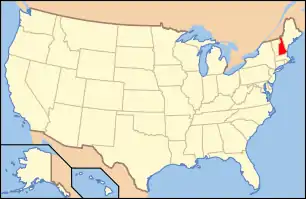| Wine region | |
 | |
| Official name | State of New Hampshire |
|---|---|
| Type | U.S. state |
| Year established | 1788 |
| Years of wine industry | 1950s-present[1] |
| Country | United States |
| Total area | 9,350 square miles (24,216 km2) |
| Size of planted vineyards | 20 |
| No. of vineyards | 5 |
| Grapes produced | Aurore, Cayuga, Chancellor, Chardonnay, De Chaunac, Diamond, Frontenac, Leon Millot, Marechal Foch, Niagara, Noiret, Riesling, Seyval blanc, Vidal blanc, Vignoles[2] |
| Varietals produced | ca 20 |
| No. of wineries | 30[3] |
New Hampshire wine refers to wine made from grapes grown in the U.S. state of New Hampshire. The wine industry in New Hampshire began in 1994 when two wineries, Jewell Towne Vineyards and Flag Hill Winery, each produced their first vintages from locally grown grapes. Candia Vineyards started their test plantings in 1992, and full planting in 1998. New Hampshire continues to be growing wine-producing state, with new commercial wineries opening. The state currently has no American Viticultural Areas.[2]
See also
References
- ↑ Cattell, Hudson (February 10, 2004). "The Wineries of New Hampshire". Appellation America.
- 1 2 "New Hampshire: Appellation Profile". Appellation America. 2007. Archived from the original on September 4, 2013. Retrieved November 28, 2008.
- ↑ "Wineries in NH". Visit NH. NH Department of Business and Economic Affairs.
This article is issued from Wikipedia. The text is licensed under Creative Commons - Attribution - Sharealike. Additional terms may apply for the media files.
